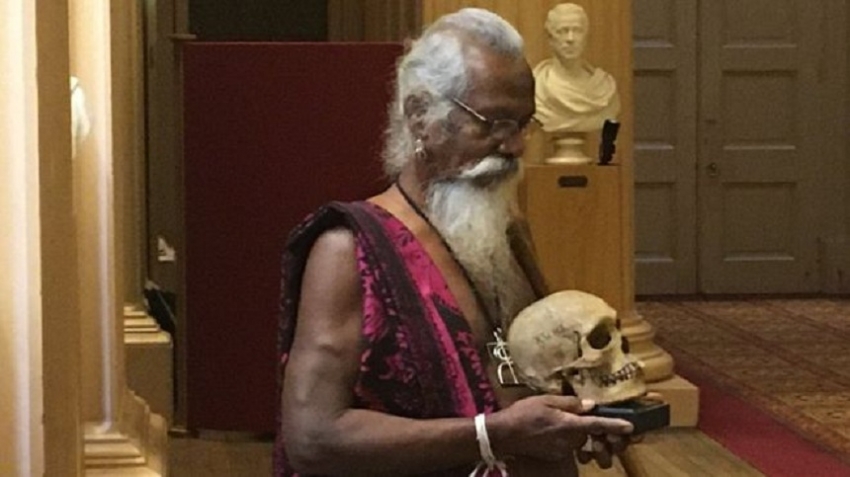The skulls of nine members of a Sri Lankan tribe have been returned to their descendents by the University of Edinburgh.Experts say the bones are the ancestral remains of the Vedda people and may be more than 200 years old.They have been part of the university's anatomical collection since being acquired at least a century ago.The skulls were presented to Vedda chief Wanniya Uruwarige at a ceremony in the university's Playfair library."The dead are very important in Vedda society," he said. "Every year we hold a special ceremony to honour those who are no longer with us."Even though these remains have been in Edinburgh for many years, their spirits have remained with us in Sri Lanka."This reuniting of spirits and physical remains - for which I thank the university - is a very special moment for my people."
It is unclear how the skulls came to be part of the university's collection, which consists of more than 12,000 objects.A study of the skulls by researchers in Germany and Edinburgh confirmed the Vedda's claim as Sri Lanka's earlier habitants.They also showed that the tribe previously lived as isolated tropical rainforest foragers. When the university offered to return the skulls to the Vedda people, they accepted.
They now plan to display the skulls in a collection showcasing their history as traditional hunter-gatherers and forest-dwellers.Researchers suggest the tribe's traditional way of life could be extinct within two generations, due to the effects of land loss and civil war.Prof Tom Gillingwater, the university's chairman of anatomy said he was delighted to welcome the Vedda people to Edinburgh."Our vast and diverse collection is often used in research breakthroughs and teaching," he said.
"We are pleased to be able to return these culturally-important artefacts to help ensure the Vedda's legacy endures for generations to come."
Manchester Museum returns 'stolen' sacred Aboriginal artefacts
21 November 2019
Share this with Facebook Share this with Messenger Share this with Twitter Share this with Email Share
Image caption
This item, made of emu feathers, is a traditional garment worn around the waist on a belt or as part of a headdress
Aboriginal artefacts taken from Australia more than 100 years ago have been handed back by museum bosses.
Indigenous leaders visited Manchester Museum to collect 12 items, including sacred ceremonial artefacts and a garment made with emu feathers.
Mangubadijarri Yanner said the treasures had been "taken without our permission" by early 20th Century British colonialists.
Museum director Esme Ward welcomed the Australian visitors "as friends".
Of the decision to return the pieces, she said repatriation was "so often framed around what we lose rather than what can be gained".
Image caption
Mangubadijarri Yanner demonstrates how one artefact is used as a headdress
Christopher Simpson, a director of the Australian Institute of Aboriginal and Torres Strait Islander Studies, said members of the delegation could not discuss or even describe the "secret sacred items" because they are deemed to be "living beings".
He said he was happy to be working with Manchester Museum because "what Manchester does today, the world will do tomorrow".
Mr Simpson said he hoped other British museums would follow suit.
Image caption
Christopher Simpson has worked with Manchester Museum for the last 10 months
Stephen Welsh, curator of Living Cultures at Manchester Museum, described the collection as "a product of empire", originally built on "racial hierarchies, cultural hierarchies, social Darwinism".
Donald Bob, elder of the Gangalidda Garawa nation, emotionally described seeing the sacred items for the first time.
He said he "felt cold because it was the person of that thing, that spirit" speaking to him "crying for his home".
Aboriginal portraits home after 170 years
Who should own indigenous art?
Eight looted artefacts to be returned to Iraq
Danny Teece-Johnson, a journalist for Australia's National Indigenous Television (NITV), told the BBC he felt "a sense of hurt and pain and anger" about the items.
"You're saying borrowed, you're saying this and that," he said. "Nah, let's talk about the white elephant in the room: You stole it, you took it without permission, that's theft.
"If you did that these days, you'd get put in jail for it."
The formal repatriation ceremony will take place at Australia House in London on Friday.
The Gangalidda Garawa delegation will return to Australia on Saturday.
Image caption
Donald Bob, elder of the Gangalidda Garawa nation, is happy to see the items returned home
A Freedom of Information request by the BBC found that, as of June, Manchester Museum had received four repatriation requests during the last 10 years.
A skull from Hawaii which an Indigenous group asked to be returned in 2010. This will remain at the museum until a clearer provenance can be determined.
A fan, also from Hawaii, made of woven grass with human hair used to stiffen the ribs. When the request was made by an Indigenous group in 2011, it was decided it would remain at the museum until suitable storage could be identified.
An Indigenous group from Canada asked for the return of several human remains in 2012. An archaeologist acting on behalf of the group concluded that there was insufficient human remains to make a claim.
The Museum of New Zealand - Te Papa Tongarewa - asked for a Moriori jawbone to be returned in 2016. It was sent back a year later.




















